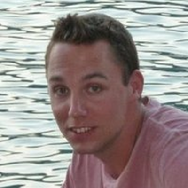Droplet dynamics on chemically striped patterned surfaces
An experimental and computational study
Promotion date: September 12.
Promotor: Prof.dr.ir. Harold Zandvliet
Assistant Promotor: Dr. Stefan Kooij
| This thesis describes droplet dynamics on chemically patterned surfaces which have anisotropic wetting properties resulting in droplets that have an elongated shape. The properties of a surface are important for the final shape a droplet can achieve. The most important parameter for chemically striped surfaces is the ratio of the widths of the high contact angle stripes and low contact angle stripes. The shape of the droplets is influenced greatly by the way the droplets are deposited on the chemically striped surfaces. The equilibrium shape of droplets on chemically striped surfaces has been simulated using Surface Evolver. When deposition is performed using low kinetic energy, a simple model predicts the droplet forms very well, approximating experimental and simulation results closely. The lattice Boltzmann model technique is used to simulate droplet spreading, evaporation and: surface wettability gradient induced droplet movement. The experiments and simulations can be quantitatively compared and the agreement between them is good, leading to a reliable tool to test surface designs. Furthermore it is shown that under evaporation circumstances the total lifetime of elongated droplets is lower than the more spherical droplets. Elongated droplets have a higher surface area with larger contact radius which leads to enhanced evaporation.
|
Was your research project fundamental in nature?
The subject under investigation is quite fundamental. My PhD project was a continuation of the work which had started already in the Physics of Interfaces & Nanomaterials (PIN) Group and was then funded by the Dutch program MicroNed, mine became part of the NanoNextNL program. Here, also industrial partners were involved. In annual meeting we reported our progress, results and research directions. The industrial members contributed in giving direction to future developments that might be of special interest to them.
Simulations and experiments interchange in this kind of research in a special way. To build promising experiments, first near-real simulation runs have to be carried out. Not every thinkable coating can be build in order to perform experiments on. The results coming from the experiments very much depend on the preliminary work of qualitatively good simulations.
For me the work was a continuation of my master thesis at the same group. So, I was well informed already when starting my PhD, which led to a steady progress all through the project. In return, I also guided bachelor and master students on aspects of this research theme, a feature of the PhD project I liked very much. It is a great thing to see students interested in the topic and taking responsibility for aspects of the project. In some cases it was surprising to see the creative contributions they came up with, which was instructive for my own work as well.
In what magazines did you publish your results?
Articles appeared in Langmuir ACS Publications and in Physical Review Letters E. Before publishing the results were first screened by the user’s group. This gave me extra time to come to a more rounded story.
In what way did you develop personally, as a researcher and scientist?
Now I work more systematically, deciding to switch in a different direction much more easily. Sometimes some courage is required to do so.
Also I learned to report my findings and research choices at all stages. Some details might appear important for the continuation of the work, or for future researchers who are willing to continue working on this topic.
What are your future plans?
First of all I go for a world travel for the next five months. This is a once in a lifetime opportunity now to do so.
After that I plan to apply for a job in industry as I would like to be involved in direct applications in future. My personal story will be more fulfilling towards friends and family then. The R&D aspects I hope to find in this future job as well, as I like to learn new things all of the time.
Did you feel part of the Mesa+ community?
I worked in the new cleanroom organization in which facilities are shared and collaborations take place on a regular basis. Within my group I was the only one to work on this subject. I collaborated with members of the Physics of Fluids (PoF) group as they were also working within the NanoNextNL program. We interchanged equipment facilities and in one case the collaboration resulted in a shared research paper. The interaction between the PIN and PoF groups is growing steadily which proved already to lead to good results.

